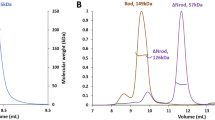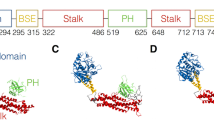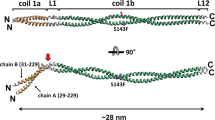Abstract
To shed light onto the activation mechanism of vinculin, we carried out a detailed refinement of chicken vinculin and compared it to the human protein which is greater than 95% identical. Refinement resulted in a complete and significantly improved model. This model includes important elements such as a pro-rich strap region (PRR) and C-terminus. The conformation of the PRR stabilized by its inter- and intra-molecular contacts shows a dynamic, but relatively stable motif that constitutes a docking platform for multiple molecules. The contact of the C-terminus with the PRR suggests that phosphorylation of Tyr1065 might control activation and membrane binding. Improved electron densities showed the presence of large solvent molecules such as phosphates/sulfates and a head-group of PIP2. The improved model allowed for a computational stability analysis to be performed by the program Corex/Best which located numerous hot-spots of increased and decreased stability. Proximity of the identified binding sites for regulatory partners involved in inducing or suppressing the activation of vinculin to the unstable elements sheds new light onto the activation pathway and differential activation. This stability analysis suggests that the activation pathway proceeds by unfurling of the super-bundle built from four bundles of helices without separation of the Vt region (840–1066) from the head. According to our mechanism, when activating proteins bind at the strap region a separation of N and C terminal bundles occurs, followed by unfurling of the super-bundle and flattening of the general shape of the molecule, which exposes the interaction sites for binding of auxiliary proteins.





Similar content being viewed by others
Data Availability
PDB code provided above.
Code Availability
No proprietary codes.
References
Geiger B, Tokoyasu KT, Dutton AH, Singer SJ (1980) Vinculin, an intracellular protein localized at specialized sites where microfilaments bundles terminate at cell membranes. Proc Natl Acad USA 77:4127–4131
Zamir E, Geiger B (2001) Molecular complexity and dynamics of cell-matrix adhesions. J Cell Sci 114:3583–3590
Ziegler WH, Liddington RC, Critchley DR (2006) The structure and regulation of vinculin. Trends Cell Biol 16:453–460
Peng X, Nelson ES, Maiers JL, DeMali KA (2011) New insights into vinculin function and regulation. Int Rev Cell Mol Biol 287:191–231
Bays JL, DeMali KA (2017) Vinculin in cell-cell and cell-matrix adhesions. Cell Mol Life Sci 74:2999–3009
Jannie KM, Ellerbroek SM, Zhou DW, Chen S, Crompton DJ, García AJ, DeMali KA (2015) Vinculin-dependent actin bundling regulates cell migration and traction forces. Biochem J 465:383–393
Thievessen I, Fakhri N, Steinwachs J, Kraus V, McIsaac RS, Gao L, Chen BC, Baird MA, Davidson MW, Betzig E, Oldenbourg R, Waterman CM, Fabry B (2015) Vinculin is required for cell polarization, migration, and extracellular matrix remodeling in 3D collagen. FASEB J 29:4555–4567
Bays JL, Peng X, Tolbert CE, Guilluy C, Angell AE, Pan Y, Superfine R, Burridge K, DeMali KA (2014) Vinculin phosphorylation differentially regulates mechanotransduction at cell–cell and cell–matrix adhesions. J Cell Biol 205:251–263
Hu K, Ji L, Applegate KT, Danuser G, Waterman-Storer CM (2007) Differential transmission of actin motion within focal adhesions. Science 315:111–115
Goldmann WH, Auernheimer V, Thievessen I, Fabry B (2013) Vinculin, cell mechanics and tumour cell invasion. Cell Biol Int 37:397–405
Kawahara E, Tokuda R, Nakanishi I (1999) Migratory phenotypes of HSC-3 squamous carcinoma cell line induced by EGF and PMA: relevance to migration of loosening of adhesion and vinculin-associated focal contacts with prominent filopodia. Cell Biol Int 23:163–174
Sadano H, Inoue M, Taniguchi S (1992) Differential expression of vinculin between weakly and highly metastatic B16-melanoma cell lines. Jpn J Cancer Res 83:625–630
Vasile VC, Edwards WD, Ommen SR, Ackerman MJ (2006) Obstructive hyper-trophic cardiomyopathy is associated with reduced expression of vinculin in the intercalated disc. Biochem Biophys Res Commun 349:709–715
Hazan RB, Kang L, Roe S, Borgen PI, Rimm DL (1997) Vinculin is associated with the E-cadherin adhesion complex. J Biol Chem 272:32448–32453
le Duc Q, Shi Q, Blonk I, Sonnenberg A, Wang N, Leckband D, de Rooji J (2010) Vinculin potentiates E-cadherin mechanosensing and is recruited to actin-anchored sites within adherens junctions in a myosin II-dependent manner. J Cell Biol 189:1107–1115
Nolz JC, Medeiros RB, Mitchell JS, Zhu P, Freedman BD, Shimizu Y, Dilladeau DD (2007) WAVE2 regulates high-affinity integrin binding by recruiting vinculin and talin to the immunological synapse. Mol Cell Biol 27:5986–6000
Ogita H, Takai Y (2008) Cross-talk among integrin, cadherin, and growth factor receptor: roles of nectin and nectin-like molecule. Int Rev Cytol 265:1–54
Gilmore AP, Burridge K (1996) Regulation of vinculin binding to talin and actin by phosphatidyl-inositol-4-5-bisphosphate. Nature 381:531–535
Humphries JD, Wang P, Streuli C, Geiger B, Humphries MJ, Ballestrem C (2007) Vinculin controls focal adhesion formation by direct interactions with talin and actin. J Cell Biol 179:1043–1057
Huttelmaier S, Bubeck P, Rudiger M, Jockusch BM (1997) Characterization of two F-actin-binding and oligomerization sites in the cell-contact protein vinculin. Eur J Biochem 247:1136–1142
Chen Y, Dokholyan NV (2006) Insights into allosteric control of vinculin function from its large scale conformational dynamics. J Biol Chem 281:29148–29154
Jao X, Chang S, Yang L, An M, Chen W (2012) Vinculin motion modes analysis with elastic network model. Int J Mol Sci 13:208–220
Golji J, Mofrad MR (2010) A molecular dynamics investigation of vinculin activation. Biophys J 99:1073–1081
Sun L, Noel JK, Levine H, Onuchic NJ (2017) Molecular simulations suggest a force-dependent mechanism of vinculin activation. Biophys J 113:1697–1710
Bakolitsa C, Cohen DM, Bankston LA, Bobkov AA, Cadwell GW, Jennings L, Critchley DR, Craig SW, Liddington RC (2004) Structural basis for vinculin activation at sites of cell adhesion. Nature 430:583–586
Borgon RA, Vonrhein C, Bricogne G, Bois PR, Izard T (2004) Crystal structure of human vinculin. Structure 12:1189–1197
Eimer W, Niermann M, Eppe MA, Jockusch BM (1993) Molecular shape of vinculin in aqueous solution. J Mol Biol 229:146–152
Winkler J, Lunsdorf H, Jockusch BM (1996) The ultrastructure of chicken gizzard vinculin as visualized by high-resolution electron microscopy. J Struct Biol 11:270–277
Brünger AT, Adams PD, Clore GM, DeLano WL, Gros P, Grosse-Kunstleve RW, Jiang JS, Kuszewski J, Nilges M, Pannu NS, Read RJ, Rice LM, Simonson T, Warren GL (1998) Crystallography and NMR system: a new software suite for macromolecular structure determination. Acta Crystallogr D Biol Crystallogr 54:905–921
Murshudov GN, Vagin AA, Dodson EJ (1997) Refinement of macromolecular structures by the maximum-likelihood method. Acta Crystallogr Sect D Biol Crystallogr 53:240–255
Emsley P, Cowtan K (2004) Coot: model-building tools for molecular graphics. Acta Crystallogr Sect D Biol Crystallogr 60:2126–2132
Painter J, Merritt EA (2006) Optimal description of a protein structure in terms of multiple groups undergoing TLS motion. Acta Crystallogr Sect D Biol Crystallogr 62:439–450
Hilser VJ, Freire E (1996) Structure based calculation of the equilibrium folding pathway of proteins. Correlation with hydrogen exchange protection factors. J Mol Biol 262:756–772
Hilser VJ, Garcia-Moreno EB, Oas TG, Kapp G, Whitten ST (2006) A statistical thermodynamic model of the protein ensemble. Chem Rev 106:1545–1558
Zhao D, Wang X, Peng J, Wang C, Li F, Sun Q, Zhang Y, Zhang J, Cai G, Zuo X, Wu J, Shi Y, Zhang Z, Gong Q (2014) Structural investigation of the interaction between the tandem SH3 domains of c-Cbl-associated protein and vinculin. J Struct Biol 187:194–205
Goldmann WH (2018) Molecular interactions between vinculin and phospholipids. Cell Biol Int 42:1076–1078
Thompson PM, Ramachandran S, Case LB, Tolbert CE, Tandon A, Pershad M, Dokholyan NV, Waterman CM, Campbell SL (2017) A structural model for vinculin insertion into PIP(2)-containing membranes and the effect of insertion on vinculin activation and localization. Structure 25:264–275
Chandrasekar I, Stradal TE, Holt MR, Entschladen F, Jockusch BM, Ziegler WH (2005) Vinculin acts as a sensor in lipid regulation of adhesion-site turnover. J Cell Sci 118:1461–1472
Auernheimer V, Lautscham LA, Leidenberger M, Friedrich O, Kappes B, Fabry B, Goldmann WH (2015) Vinculin phosphorylation at residues Y100 and Y1065 is required for cellular force transmission. J Cell Sci 128:3435–3443
Chen H, Cohen DM, Choudhury DM, Kioka N, Craig SW (2005) Spatial distribution and functional significance of activated vinculin in living cells. J Cell Biol 169:459–470
Mandai K, Nakanishi H, Satoh A, Takahashi K, Satoh K, Nishioka H, Mizoguchi A, Takai Y (1999) Ponsin/SH3P12: an l-afadin- and vinculin-binding protein localized at cell-cell and cell–matrix adherens junctions. J Cell Biol 144:1001–1017
Kioka N, Sakata S, Kawauchi T, Amachi T, Akiyama SK, Okazaki K, Yaen C, Yamada KM, Aota S (1999) Vinexin: a novel vinculin-binding protein with multiple SH3 domains enhances actin cytoskeletal organization. J Cell Biol 144:59–69
Yamashita H, Ichikawa T, Matsuyama D, Kimura Y, Ueda K, Craig SW, Harada I, Kioka N (2014) The role of the interaction of the vinculin proline-rich linker region with vinexin α in sensing the stiffness of the extracellular matrix. J Cell Sci 127:1875–1886
DeMali KA, Barlow CA, Burridge K (2002) Recruitment of the Arp2/3 complex to vinculin: coupling membrane protrusion to matrix adhesion. J Cell Biol 159:881–891
Kawabe H, Hata Y, Takeuchi M, Ide N, Mizoguchi A, Takai Y (1999) nArgBP2, a novel neural member of ponsin/ArgBP2/vinexin family that interacts with synapse-associated protein 90/postsynaptic density-95-associated protein (SAPAP). J Biol Chem 274:30914–30918
Reinhard M, Rüdiger M, Jockusch BM, Walter U (1996) VASP interaction with vinculin: a recurring theme of interactions with proline-rich motifs. FEBS Lett 399:103–107
Young JS, Vogl AW (2012) Focal adhesion proteins Zyxin and Vinculin are co-distributed at tubulobulbar complexes. Spermatogenesis 2:63–68
Huttelmaier S, Mayboroda O, Harbeck B, Jarchau T, Jockusch BM, Rudiger M (1998) The interaction of the cell-contact proteins VASP and vinculin is regulated by phosphatidylinositol-4,5-bisphosphate. Curr Biol 8:479–488
Beck K (1989) Structural model of vinculin: correlation of amino acid sequence with electron macroscopical shape. FEBS Lett 249:1–4
Winkler J, Jockusch BM (2000) 3-Dimensional organization of the N-terminal vinculin head domain. Eur J Cell Biol 80:201–206
Chen H, Choudhury DM, Craig SW (2006) Coincidence of actin filaments and talin is required to activate vinculin. J Biol Chem 281:40389–40398
Cohen DM, Chen H, Johnson RP, Choudhury B, Craig SW (2005) Two distinct head–tail interfaces cooperate to suppress activation of vinculin by talin. J Biol Chem 280:17109–17117
Cohen DM, Kutscher B, Chen H, Murphy DB, Craig SW (2006) A conformational switch in vinculin drives formation and dynamics of a talin–vinculin complex at focal adhesions. J Biol Chem 281:16006–16015
Machiyama H, Morikawa TJ, Okamoto K, Watanabe TM, Fujita H (2017) The use of a genetically encoded molecular crowding sensor in various biological phenomena. Biophys Physicobiol 14:119–125
Grashoff C, Hoffman BD, Brenner MD, Zhou R, Parsons M, Yang MT, McLean MA, Sligar SG, Chen CS, Ha T, Schwartz MA (2012) Measuring mechanical tension across vinculin reveals regulation of focal adhesion dynamics. Nature 466:263–266
Chorev DS, Volberg T, Livne A, Eisenstein M, Martins B, Kam Z, Jockusch BM, Medalia O, Sharon M, Geiger B (2018) Conformational states during vinculin unlocking differentially regulate focal adhesion properties. Sci Rep 8:2693
Thievessen I, Thompson PM, Berlemont S, Plevock KM, Plotnikov SV, Zemljic-Harpf A, Ross RS, Davidson MW, Danuser G, Campbell SL, Waterman CM (2013) Vinculin–actin interaction couples actin retrograde flow to focal adhesions, but is dispensable for focal adhesion growth. J Cell Biol 202:163–177
Case LB, Baird MA, Shtengel G, Campbell SL, Hess HF, Davidson MW, Waterman CM (2015) Molecular mechanism of vinculin activation and nanoscale spatial organization in focal adhesions. Nat Cell Biol 17:880–892
Kanchanawong P, Shtengel G, Pasapera AM, Ramko EB, Davidson MW, Hess HF, Waterman CM (2010) Nanoscale architecture of integrin-based cell adhesions. Nature 468:580–584
del Rio A, Perez-Jimenez R, Liu R, Roca-Cusachs P, Fernandez JM, Sheetz MP (2009) Stretching single talin rod molecules activates vinculin binding. Science 323:638–641
Izard T, Evans G, Borgon RA, Rush CL, Bricogne G, Bois PR (2004) Vinculin activation by talin through helical bundle conversion. Nature 427:171–175
Bois PR, O’Hara BP, Nietlispach D, Kirkpatrick J, Izard T (2006) The vinculin binding sites of talin and alpha-actinin are sufficient to activate vinculin. J Biol Chem 281:7228–7236
Choe S, Sun SX (2005) The elasticity of α-helices. J Chem Phys 122:244912
Kern D, Zuiderweg ER (2003) The role of dynamics in allosteric regulation. Curr Opin Struct Biol 13:748–757
Critchley DR (2000) Focal adhesions—the cytoskeletal connection. Curr Opin Cell Biol 12:133–139
Geiger B, Bershadsky A, Pankov R, Yamada KM (2001) Transmembrane crosstalk between the extracellular matrix–cytoskeleton crosstalk. Nat Rev Mol Cell Biol 2:793–805
Jockusch BM, Rudiger M (1996) Crosstalk between cell adhesion molecules: vinculin as a paradigm for regulation by conformation. Trends Cell Biol 6:311–315
Coll JL, Ben-Ze’ev A, Ezzell RM, Rodriguez Fernandez JL, Baribault H, Oshima RG, Adamson ED (1995) Targeted disruption of vinculin genes in F9 and embryonic stem cells changes cell morphology, adhesion, and locomotion. Proc Natl Acad USA 92:9161–9165
Volberg T, Geiger B, Kam Z, Pankov R, Simcha I, Sabanay H, Coll JL, Adamson E, Ben-Ze’ev A (1995) Focal adhesion formation by F9 embryonal carcinoma cells after vinculin gene disruption. J Cell Sci 108:2253–2260
Xu W, Baribault H, Adamson ED (1998) Vinculin knockout results in heart and brain defects during embryonic development. Development 125:327–337
Saunders RM, Holt MR, Jennings L, Sutton DH, Barsukov IL, Bobkov A, Liddington RC, Adamson EA, Dunn GA, Critchley DR (2006) Role of vinculin in regulating focal adhesion turnover. Eur J Cell Biol 85:487–500
Chorev DS, Moscovitz O, Geiger B, Sharon M (2014) Regulation of focal adhesion formation by a vinculin-Arp2/3 hybrid complex. Nat Commun 5:3758
Pasapera AM, Schneider IC, Rericha E, Schlaepfer DD, Waterman CM (2010) Myosin II activity regulates vinculin recruitment to focal adhesions through FAK-mediated paxillin phosphorylation. J Cell Biol 188:877–890
Goult BT, Zacharchenko T, Bate N, Tsang R, Hey F, Gingras AR, Elliott PR, Roberts GC, Ballestrem C, Critchley DR, Barsukov IL (2013) RIAM and vinculin binding to talin are mutually exclusive and regulate adhesion assembly and turnover. J Biol Chem 288:8238–8249
Golji J, Wendorff T, Mofrad MR (2012) Phosphorylation primes vinculin for activation. Biophys J 102:2022–2030
Lee JH, Rangarajan ES, Vonrhein C, Bricogne G, Izard T (2012) The metavinculin tail domain directs constitutive interactions with raver1 and vinculin RNA. J Mol Biol 422:697–704
Zhang Z, Izaguirre G, Lin SY, Lee HY, Schaefer E, Haimovich B (2004) The phosphorylation of vinculin on tyrosine residues 100 and 1065, mediated by SRC kinases, affects cell spreading. Mol Biol Cell 15:4234–4247
Kelley CF, Litschel T, Schumacher S, Dedden D, Schwille P, Mizuno N (2020) Phosphoinositides regulate force-independent interactions between talin, vinculin, and actin. Elife 9:e56110
Boujemaa-Paterski R, Martins B, Eibauer M, Beales CT, Geiger B, Medalia O (2020) Talin-activated vinculin interacts with branched actin networks to initiate bundles. Elife 9:e53990
Shen K, Tolbert CE, Guilluy C, Swaminathan VS, Berginski ME, Burridge K, Superfine R, Campbell SL (2011) The vinculin C-terminal hairpin mediates F-actin bundle formation, focal adhesion, and cell mechanical properties. J Biol Chem 286:45103–45115
Diez G, Kollmannsberger P, Mierke CT, Koch TM, Vali H, Fabry B, Goldmann WH (2009) Anchorage of vinculin to lipid membranes influences cell mechanical properties. Biophys J 97:3105–3112
Janssen ME, Kim E, Liu H, Fujimoto LM, Bobkov A, Volkmann N, Hanein D (2006) Three dimensional structure of vinculin bound to actin filaments. Mol Cell 21:271–281
Golji J, Mofrad MR (2013) The interaction of vinculin with actin. PLoS Comput Biol 9(4):e1002995
Kim LY, Thompson PM, Lee HT, Pershad M, Campbell SL, Alushin GM (2016) The structural basis of actin organization by vinculin and metavinculin. J Mol Biol 428:10–25
Hüttelmaier S, Bubeck P, Rüdiger M, Jockusch BM (1997) Characterization of twoF-actin-binding and oligomerization sites in the cell-contact protein vinculin. Eur J Biochem 247:1136–1142
Thompson PM, Tolbert CE, Campbell SL (2013) Vinculin and metavinculin: oligomerization and interactions with F-actin. FEBS Lett 587:1220–1229
Janssen ME, Liu H, Volkmann N, Hanein D (2012) The C-terminal tail domain of metavinculin, vinculin’s splice variant, severs actin filaments. J Cell Biol 197:585–593
Acknowledgements
We would like to thank Jason Vertrees and Vincent Hilser for help in performing the computation stability using Corex/Best on vinculin model. Special acknowledgment goes to Robert Liddington for inspiration and partial financial support during my stay at the Burnham Institute for Medical Research (Sanford Burnham Prebys Medical Discovery Institute).
Funding
No funding reported.
Author information
Authors and Affiliations
Contributions
DLS carried out the computations, analyzed the data, wrote the manuscript, BS conceived the project, carried out crystallographic analysis, wrote the manuscript.
Corresponding author
Ethics declarations
Conflict of interest
The authors declared that they have no conflict of interest.
Ethical Approval
No ethics conflicts declared.
Consent to Participate
Both authors participated and no other consent was sought.
Consent for Publication
Both authors participated and consented to publishing.
Additional information
Publisher's Note
Springer Nature remains neutral with regard to jurisdictional claims in published maps and institutional affiliations.
Supplementary Information
Below is the link to the electronic supplementary material.
Rights and permissions
About this article
Cite this article
Stec, D.L., Stec, B. Complete Model of Vinculin Suggests the Mechanism of Activation by Helical Super-Bundle Unfurling. Protein J 41, 55–70 (2022). https://doi.org/10.1007/s10930-022-10040-1
Accepted:
Published:
Issue Date:
DOI: https://doi.org/10.1007/s10930-022-10040-1




